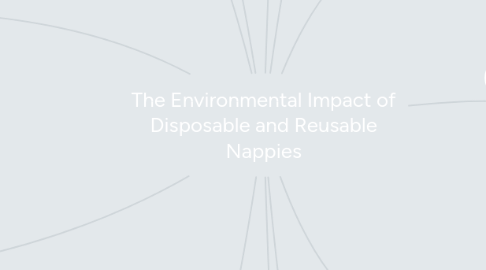
1. Statistics
1.1. In a home with one baby using disposables, 50% of the household's waste will be nappies (1)
1.2. In 2009, Australian babies used 2.1 billion nappies - about 5.6 million per day (2)
1.3. 95% of nappies used in Australia today are disposable, up from 40% in 1993 (3)
2. History Behind Diapers
2.1. Marion Donovan born in 1917, Fort Wayne, Indiana invented the first disposable diaper (4)
2.2. The first diaper was named 'Boater'
2.3. Pampers
3. Reusable Nappies
3.1. Pros
3.1.1. Reusable
3.1.2. Takes longer to reach landfill
3.1.3. Organic options available
3.1.4. Better impact on the environment
3.1.5. You as a user have more control over the environmental impact
3.2. Cons
3.2.1. Washing Cost and the amount of water used to keep it cleaned and able to be reused
3.2.2. Energy Use
3.2.3. Raw material Sourcing
4. Solid Waste
4.1. Where does it get disposed?
4.2. How long does it take to get to landfill?
4.3. What happens to the toxins that the nappy releases?
4.3.1. Contamination?
4.3.1.1. Environment
4.3.1.2. Biodiversity
4.3.1.3. Humans
5. Research Questions
5.1. Do the impacts on the environment outweigh the convenience of disposable nappies?
5.2. Are both Reusable and Disposable nappies biodegradable?
5.3. What are the end of life options for nappies?
5.4. Does environmental awareness reduce your eco footprint?
5.5. Is reusable or non-reusable energy used in the manufacturing of disposable and reusable nappies?
5.6. What raw materials are used in the manufacturing of reusable and disposable nappies?
5.7. What is the difference in Life cycle stage in which water resource consumption is most used for both disposable and reusable nappies?
5.8. Are reusable nappies more environmentally sustainable than disposable nappies?
5.9. Which area needs the most improvement for disposable nappies to be more environmentally sustainable like cloth nappies?
6. How are they made?
6.1. Manufacturing
6.1.1. Process
6.1.1.1. Environmental Impact to produce?
6.2. Materials
6.2.1. Recyclable
6.2.2. Toxic
6.2.3. Biodegradable
7. End Of Life
7.1. Landfill
7.1.1. "It will take 200 to 500 years for a disposable nappy to decompose..." (2)
7.2. Recycled
7.3. Re-use
8. Sustainable Parenting
8.1. Who is the Disposable Nappy convenient for?
8.1.1. Parents on the Go
8.2. Who is the Reusable Nappy convenient for?
8.2.1. Parents looking to save $$$
8.2.2. Parents looking into more sustainable resources
9. Purpose of a Nappy
9.1. Absorb Fluid
9.2. Retain Moisture
10. Disposable Nappies
10.1. Pros
10.1.1. Eco Friendly options available
10.1.2. Recycling services are being explored such as Terracycle https://www.terracycle.com.au/en-AU/
10.1.2.1. Zero Waste Box
10.1.2.2. Nappies being recycled and turned into plastic products
10.1.2.3. Founded by Ernie Simpson
10.2. Cons
10.2.1. Harming environment through manufacture and disposal
10.2.2. Chemicals used such as Sodium Polyacrylate to turn the wee into gel
10.2.3. Use of raw materials is extensive
11. Energy Consumption
11.1. Energy use difference to manufacture and maintain
11.2. Energy needed in order to maintain
11.2.1. Disposable/Production Phase
11.2.2. Reusable/Cleaning in order to maintain

